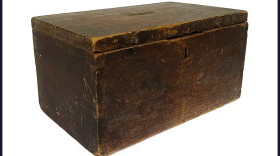-
This week we'll be talking with Dr. Jennifer Whitmer Taylor of Duquesne University about her book, Rebirth: Creating the Museum of the Reconstruction Era and the Future of the House Museum (2025, University of SC Press).In Rebirth, Taylor provides a compelling account of how to reenvision the historic house museum. Using the Museum of the Reconstruction Era—known as the Woodrow Wilson Family Home for most of its many years as a house museum—as a case study, Taylor explores the challenges and possibilities that face public history practitioners and museum professionals who provide complex interpretations of contested public memory.
-
“M “is for Moses, Franklin J., Jr. (ca.1840 to 1906). Governor.
-
“M “is for Moses, Franklin J., Jr. (ca.1840 to 1906). Governor.
-
“G” is for Grimké, Archibald Henry (1849-1930). Activist, scholar.
-
“G” is for Grimké, Archibald Henry (1849-1930). Activist, scholar.
-
In his book Grant’s Enforcer: Taking Down the Klan Guy Gugliota offers a gripping story of the early years after the Civil War and the campaign led by President Ulysses S. Grant’s attorney general Amos T. Akerman to destroy the Ku Klux Klan. Akerman, a former Georgia slaveholder and the only Southerner to serve in a Reconstruction cabinet, was the first federal lawman to propose using the Fourteenth Amendment to prosecute civil rights violations.Gugliotta uses newspapers, documents, and first-person stories, including thousands of pages of testimony under oath taken by a Congressional joint committee tasked in 1871 to study the Ku Klux Klan, a breathtaking compilation of accounts by Ku Klux targets, their attackers, local and national politicians, public officials and private citizens. The result is a vivid portrait of the Reconstruction South through the career of this surprising man.Guy joins us in conversation this week to talk about how Grant and Akerman took down the Klan.
-
“S” is for Smalls, Robert (1839-1915.) Legislator, congressman.
-
“S” is for Smalls, Robert (1839-1915.) Legislator, congressman.
-
This week, we’ll be talking with Betsy Teter and Jim Neighbors about their book, North of Main: Spartanburg's Historic Black Neighborhoods of North Dean Street, Gas Bottom, and Back of the College. In this book, co-authors Brenda Lee Pryce, Betsy Teter and Jim Neighbors tell the story of how post-emancipation black districts arose in Spartanburg and how they disappeared.
-
“R” is for Rollin sisters. During Reconstruction Frances, Lottie, Louisa, and Kate were active in South Carolina politics and their Columbia home became an important, if informal, venue for Republican Party leaders in Reconstruction South Carolina.

Play Live Radio
Next Up:
0:00
0:00
Available On Air Stations




